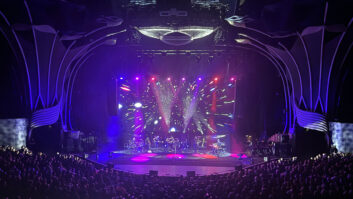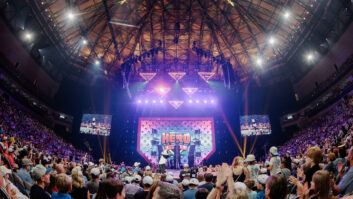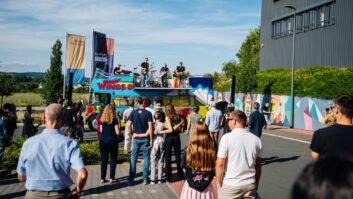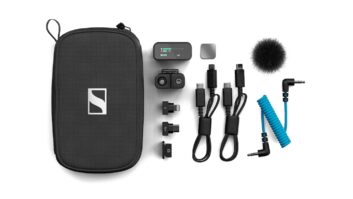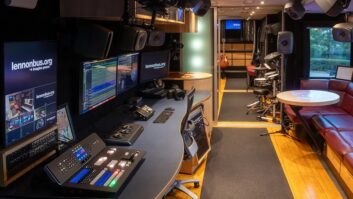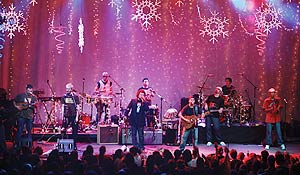

On a typical rock tour, the crew often outnumbers the band by a large margin. But when the nine members of Ozomatli hit the road, their support staff occupies the smallest space on the bus. And, yes, we do mean one bus. “Normally, a 9-piece band would have a 6-man road crew,” says tour manager/front-of-house engineer Patrick Murray, whose FOH credits include jazz great John Scofield, Shakira, Santana and Miles Davis, among others. “There’s only 12 bunks on the bus, so that means three of us are out here crewing for these guys.”
Needless to say, those three individuals — Murray, monitor engineer/backline tech Brian Simakis and production assistant/merchandiser Joe Priester — remained in constant motion during Ozomatli’s 2007 Winter on Ice tour, which skated through the Western U.S. from mid-November through late December. Mix caught up with Ozomatli and their hard-working crew on the final night of a successful four-night residency at San Francisco’s Fillmore Auditorium. Hip hop act Lifesavas, from Portland, Ore., opened the show, and would join the band for the next two weeks.
Photo: Steve Jennings
During their 12-year career, Ozomatli has amassed an avid worldwide fan base for their rhythmic mix of Latin, hip hop, reggae and Middle Eastern funk. They’ve drawn equal respect for their commitment to human rights issues and for touring locales such as Kathmandu, Nepal — the first American band to do so.
After a brief announcement from a representative of San Francisco 8, the collective of eight former Black Panthers currently in prison with bail set at $3 million each for charges related to the 1971 killing of a San Francisco police officer, Ozomatli and their mass of Latin and Indian percussion, horns, sax, keyboards, acoustic guitar and bass assumed the stage for a lengthy set culled mainly from their new release, Don’t Mess With the Dragon, their fourth studio album and third from Concord Records.
Murray uses 36 channels of the Fillmore’s 56-input Midas H2000 console, and for this tour relied on venue-provided outboard gear. In the case of the Fillmore, he has a solid collection at his disposal. “If the P.A. is set up correctly and we have a reliable console and good input signals, we’re fine,” says Murray. “We carry our own mics and monitor board, which keeps things consistent.” The band travels with a Shure-endorsed mic assortment comprising SM57s, Beta 56s and Beta 57As for drums, percussion and guitars; Beta 58As for vocals; SM7Bs for the brass; and a Beta 57A for sax. KSM137s are used as percussion overheads and for hi-hat and tablas; KSM32s handle drum overheads with Beta 98s on toms. The band has four Shure UR24S wireless systems: two with KSM9 capsules for lead vocalist/trumpeter Asdrubal Sierra and bassist Wil-Dog Abers’ vocals, and two SM87C capsules for rapper Trey Hardson and percussionist Justin Porée.
Due to the band’s large size and high activity level (bandmembers constantly move around and switch instruments), Murray rarely has an opportunity to “set it and forget it.” “With nine people onstage, you’re generating a lot of information,” he says. “It’s not the type of music that has a lot of open space. It’s difficult to layer in the different percussion instruments and other parts, including a horn section, MCs, multiple vocals and other various effects. The challenge is to keep a three-dimensional mix happening without everything falling on top of each other. The arrangements are quite dense.”
To keep Ozomatli’s intricate instrumentation in check, Murray takes a straightforward approach to mixing, using minimal effects and few gimmicks. He uses a Summit DCL-200 for Sierra and guitarist Raul Pacheco’s vocals, XTA C2 compressors for the horns, dbx 160 on bass and a BSS DPR-404 4-channel compressor. “I use one channel each for the two rap vocalists, one channel in stereo mode assigned to a group where I bus the other three background vocalists: Uli [Bella], Sheffer [Bruton] and Wil-Dog.”
On drums, Murray uses a time-tested studio technique. “I have a TC Electronic D-Two for delay and slap echoes, a [Yamaha] SPX990 for drum reverb, TC Electronic M2000 for vocal ‘verb and a TC M-One,” he says. “I’m using both engines of the M-One: One as a short hall reverb for the horns to give them a little dimension and to separate them out a little bit, and on the other side I use a pitch-shift program to thicken up some of the horn parts for certain songs, just a little plus-minus 4 cents with a little bit of delay to add depth and make the horn section sound a little bit bigger. Then I take the horns an octave down, specifically on the song ‘Saturday Night,’ to give an extra womp to the horn section.”
In addition to the live instruments, drummer Mario Calire incorporates various loops and samples triggered on a 360 Systems playback machine. Standing next to Calire (some of the time), percussionist Porée plays a Roland Octapad loaded with other one-shot samples and effects, which are used mainly on some of the band’s early material.
For reference, Murray records each show using an M-Audio MicroTrack pocket digital recorder. In 2005, however, the band recorded their San Francisco dates for the popular Live From the Fillmore CD. “This is my fourth year with the band, and we’ve played the Fillmore every year,” says Murray. “They really make us feel at home. We know everybody on a first-name basis; it’s really comfortable for us. The Fillmore is one of the greatest clubs in America, hands-down. They have top-notch people, the room sounds great, with state-of-the-art sound equipment.” That includes a Meyer P.A. system with six MICA line array loudspeakers per side, one underhung DF-4 powered down-fill per side and a flown CQ-2 for center-fill.
Even more important than the gear, Ozomatli has a strong fan base in the Bay Area. During their four-night residency, two nights were sold out while the other two were very near capacity. “The crowds in S.F. rival the crowds from L.A., and the band is from L.A.,” Murray adds.
MONITORS IN MOTION
Monitor engineer Brian Simakis — who joined the Ozomatli team at the start of the Winter on Ice tour — works on a Crest LM console supplied by Shaped Music from Fort Collins, Colo. He created 11 mixes during the Fillmore dates, including six wireless in-ear mixes, four wedge mixes, a drum sub and a hard-wired ear mix for the drummer. Saxophonist Bella and trombonist Bruton use Meyer UM1 wedges, and Simakis dedicates additional UM1s to the bass and keyboards. “Asdru [Sierra] has a little bit in his ears, but he wants to hear a little in the wedge, too. But Uli will also play keys, and he doesn’t have any in-ears so he needs to hear through the key wedge.” Bassist Abers also uses the Sennheiser EW300 IEMs, but has a bass wedge nearby so he can feel the “oomph” of the low end.
Simakis works with mostly the first-generation EW300 system, as well as the Shure UR4D dual-channel receiver. “When you’re traveling to different venues, every day is a hunt for clean channels,” he says. “But the UR4D has a self-scan function that’s been very helpful.” Simakis uses graphs for the wedges and the drum sub, which is taken direct out of the kick channel.
Like Murray, Simakis keeps his mixes “pretty cut and dry.” “I make a lot of moves during songs,” he says. “The guys want different things here and there, and they switch a lot of the leads. Depending on the vocal lead, the drummer might want more Raul vocal, then on a song where he doesn’t need much we turn it down again. I have to watch the guys all the time, but I appreciate the challenge.”
Simakis received the challenge by way of engineer Scott Southern, Ozomatli’s monitor engineer since May 2006. When Southern decided to take a breather, Simakis took over the reins. Likewise, Murray often gets a break when the band plays their hometown, where they frequently work with engineer Eduardo “Mack” Mackinlay. “They’re a force to be reckoned with,” Southern says of the band. “The challenge was having two eyes and nine people!”
By the nature of their music, Ozomatli puts a strain on their engineers, so the nine members do their best to lend a hand when they can. “On fly dates, when it is often just me and the band, Wil-Dog will jump behind the monitor board and get the monitor mix together,” says Murray. “They’re not pretentious enough to say, ‘I can’t do that.’ It’s all about the show and making it happen.”
And happen it does, with unyielding energy right to the last song of the encore. “It’s quite an event to go to an Ozomatli show,” says Murray. “You must dance. But from a sound standpoint, it’s a demanding show to mix. That’s why I came onboard. Not only do I like the music, but it’s a challenge to me as an engineer.”
Heather Johnson is a freelance music writer and serves on the Board of Governors for the San Francisco chapter of NARAS.

WATCH:
Ozomatli Photo Gallery


